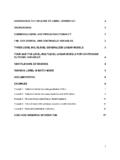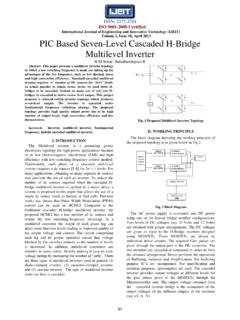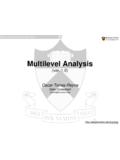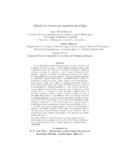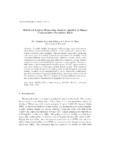Transcription of The Basic Two-Level Regression Model - Joop Hox
1 14:20:25:01:10 Page 11 Page 112 The Basic Two-Level Regression ModelThe multilevel Regression Model has become known in the research literature under avariety of names, such as random coefficient Model (de Leeuw & Kreft, 1986; Long-ford, 1993), variance component Model (Longford, 1987), and hierarchical linearmodel (Raudenbush & Bryk, 1986, 1988). Statistically oriented publications tend torefer to the Model as a mixed-effects or mixed Model (Littell, Milliken, Stroup, &Wo lfinger, 1996). The models described in these publications are not exactly the same,but they are highly similar, and I will refer to them collectively as multilevel regressionmodels . They all assume that there is a hierarchical data set, with one single outcomeor response variable that is measured at the lowest level, and explanatory variables atall existing levels .
2 Conceptually, it is useful to view the multilevel Regression Model as ahierarchical system of Regression equations. In this chapter, I will explain the multilevelregression Model for Two-Level data, and also give an example of three-level models with more than two levels are also used in later EXAMPLEA ssume that we have data from J classes, with a different number of pupils nj in eachclass. On the pupil level, we have the outcome variable popularity (Y), measured by aself-rating scale that ranges from 0 (very unpopular) to 10 (very popular). We have twoexplanatory variables on the pupil level: pupil gender (X1: 0 = boy, 1 = girl) and pupilextraversion (X2, measured on a self-rating scale ranging from 1 to 10), and one classlevel explanatory variable teacher experience (Z: in years, ranging from 2 to 25).
3 Thereare data on 2000 pupils in 100 classes, so the average class size is 20 pupils. The data aredescribed in Appendix analyze these data, we can set up separate Regression equations in each classto predict the outcome variable Y using the explanatory variables X as follows:Yij= 0j+ 1jX1ij+ 2jX2ij+eij.( )Using variable labels instead of algebraic symbols, the equation reads:popularityij= 0j+ 1jgenderij+ 2jextraversionij+eij.( )1114:20:25:01:10 Page 12 Page 12In this Regression equation, 0j is the intercept, 1j is the Regression coefficient (regres-sion slope) for the dichotomous explanatory variable gender, 2j is the Regression coef-ficient (slope) for the continuous explanatory variable extraversion, and eij is the usualresidual error term. The subscript j is for the classes (j = 1 .. J) and the subscript i isfor individual pupils (i = 1.)
4 Nj). The difference with the usual Regression Model is thatwe assume that each class has a different intercept coefficient 0j, and different slopecoefficients 1j and 2j. This is indicated in equations and by attaching a sub-script j to the Regression coefficients. The residual errors eij are assumed to have a meanof zero, and a variance to be estimated. Most multilevel software assumes that thevariance of the residual errors is the same in all classes. Different authors (seeGoldstein, 2003; Raudenbush & Bryk, 2002) use different systems of notation. Thisbook uses 2e to denote the variance of the lowest level residual the intercept and slope coefficients are random variables that vary acrossthe classes, they are often referred to as random In our example, thespecific values for the intercept and the slope coefficients are a class characteristic.
5 Ingeneral, a class with a high intercept is predicted to have more popular pupils than aclass with a low value for the Similarly, differences in the slope coefficient forgender or extraversion indicate that the relationship between the pupils gender orextraversion and their predicted popularity is not the same in all classes. Some classesmay have a high value for the slope coefficient of gender; in these classes, the differencebetween boys and girls is relatively large. Other classes may have a low value for theslope coefficient of gender; in these classes, gender has a small effect on the popularity,which means that the difference between boys and girls is small. Variance in the slopefor pupil extraversion is interpreted in a similar way; in classes with a large coefficientfor the extraversion slope, pupil extraversion has a large impact on their popularity,and vice all classes, the Regression coefficients j are assumed to have a multivariatenormal distribution.
6 The next step in the hierarchical Regression Model is to explain thevariation of the Regression coefficients j introducing explanatory variables at the classlevel: 0j= 00+ 01Zj+u0j,( )1At the end of this chapter, a section explains the difference between some commonly used notationsystems. Models that are more complicated sometimes need a more complicated notation system,which is introduced in the relevant course, we hope to explain at least some of the variation by introducing higher-level , we will not be able to explain all the variation, and there will be some unexplainedresidual the Model contains a dummy variable for gender, the precise value of the intercept reflects thepredicted value for the boys (coded as zero). Varying intercepts shift the average value for the entireclass, both boys and ANALYSIS: TECHNIQUES AND APPLICATIONS14:20:25:01:10 Page 13 Page 13and 1j= 10+ 11Zj+u1j 2j= 20+ 21Zj+u2j.
7 ( )Equation predicts the average popularity in a class (the intercept 0j) by theteacher s experience (Z). Thus, if 01 is positive, the average popularity is higher inclasses with a more experienced teacher. Conversely, if 01 is negative, the averagepopularity is lower in classes with a more experienced teacher. The interpretation ofthe equations under is a bit more complicated. The first equation under statesthat the relationship, as expressed by the slope coefficient 1j, between the popularity(Y) and the gender (X) of the pupil, depends on the amount of experience of theteacher (Z). If 11 is positive, the gender effect on popularity is larger with experiencedteachers. Conversely, if 11 is negative, the gender effect on popularity is smaller withexperienced teachers.
8 Similarly, the second equation under states, if 21 is positive,that the effect of extraversion is larger in classes with an experienced teacher. Thus, theamount of experience of the teacher acts as a moderator variable for the relationshipbetween popularity and gender or extraversion; this relationship varies according tothe value of the moderator u-terms u0j, u1j and u2j in equations and are (random) residual errorterms at the class level. These residual errors uj are assumed to have a mean of zero,and to be independent from the residual errors eij at the individual (pupil) level. Thevariance of the residual errors u0j is specified as 2u0, and the variance of the residualerrors u1j and u2j is specified as 2u1 and 2u2. The covariances between the residual errorterms are denoted by u01, u02 and u12, which are generally not assumed to be that in equations and the Regression coefficients are not assumedto vary across classes.
9 They therefore have no subscript j to indicate to which classthey belong. Because they apply to all classes, they are referred to as fixed between-class variation left in the coefficients, after predicting these with theclass variable Zj, is assumed to be residual error variation. This is captured by theresidual error terms uj, which do have subscripts j to indicate to which class Model with two pupil-level and one class-level explanatory variable can bewritten as a single complex Regression equation by substituting equations and equation Rearranging terms gives:Yij= 00+ 10X1ij+ 20X2ij+ 01Zj+ 11X1ijZj+ 21X2ijZj+u1jX1ij+u2jX2ij+u0j+eij.( )Using variable labels instead of algebraic symbols, we have:The Basic Two-Level Regression Model1314:20:25:01:10 Page 14 Page 14popularityij= 00+ 10 genderij+ 20 extraversionij+ 01 experiencej+ 11 genderij experiencej+ 21 extraversionij experiencej+u1j genderij+u2j extraversionij+u0j+ segment [ 00 + 10 X1ij + 20 X2ij + 01Zj + 11 X1ijZj + 11 X2ijZj] in equation containsthe fixed coefficients.
10 It is often called the fixed (or deterministic) part of the segment [u1jX1ij + u2jX2ij + u0j + eij] in equation contains the random error terms,and it is often called the random (or stochastic) part of the Model . The terms X1iZjj andX2ijZj are interaction terms that appear in the Model as a consequence of modeling thevarying Regression slope j of a pupil level variable Xij with the class level variable , the moderator effect of Z on the relationship between the dependent variable Yand the predictor X, is expressed in the single equation version of the Model as a cross-level interaction. The interpretation of interaction terms in multiple Regression analysisis complex, and this is treated in more detail in Chapter 4. In brief, the point made inChapter 4 is that the substantive interpretation of the coefficients in models withinteractions is much simpler if the variables making up the interaction are expressed asdeviations from their respective that the random error terms u1j are connected to Xij.




